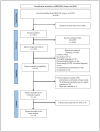Characteristics, Components, and Efficacy of Telerehabilitation Approaches for People with Chronic Obstructive Pulmonary Disease: A Systematic Review and Meta-Analysis
- PMID: 36429887
- PMCID: PMC9691096
- DOI: 10.3390/ijerph192215165
Characteristics, Components, and Efficacy of Telerehabilitation Approaches for People with Chronic Obstructive Pulmonary Disease: A Systematic Review and Meta-Analysis
Abstract
Introduction: Chronic obstructive pulmonary disease (COPD) is at the top of the list of non-communicable diseases with related rehabilitation needs. Digital medicine may provide continuative integrated intervention, overcoming accessibility and cost barriers.
Methods: We systematically searched for randomized controlled trials on telerehabilitation (TR) in people with COPD to profile the adopted TR strategies, focusing on TR models and the main rehabilitation actions: monitoring and assessment, decision, and feedback. Additionally, a meta-analysis was run to test the TR effect on functional capacity, dyspnea, and quality of life compared to no intervention (NI) and conventional intervention (CI).
Results: Out of the 6041 studies identified, 22 were eligible for the systematic review, and 14 were included in the meta-analyses. Results showed a heterogeneous scenario in terms of the TR features. Furthermore, only a small group of trials presented a comprehensive technological kit. The meta-analysis highlighted a significant effect of TR, especially with the asynchronous model, on all outcomes compared to NI. Moreover, a non-inferiority effect of TR on functional capacity and quality of life, and a superiority effect on dyspnea compared to CI were observed. Finally, the studies suggested a high rate of TR adherence and high safety level.
Conclusions: TR is an effective strategy to increase and maintain functional capacity, breath, and quality of life in people with COPD. However, a consensus on the essential elements and features of this approach needs to be defined, and the effect of long-term maintenance merits further investigation.
Keywords: chronic obstructive pulmonary disease; continuity of care; digital medicine; pulmonary; rehabilitation; telerehabilitation.
Conflict of interest statement
The authors declared no potential conflict of interest concerning the research, authorship, and/or publication of this article.
Figures







References
-
- Ryrsø C.K., Godtfredsen N.S., Kofod L.M., Lavesen M., Mogensen L., Tobberup R., Farver-Vestergaard I., Callesen H.E., Tendal B., Lange P., et al. Lower mortality after early supervised pulmonary rehabilitation following COPD-exacerbations: A systematic review and meta-analysis. BMC Pulm. Med. 2018;18:154. doi: 10.1186/s12890-018-0718-1. - DOI - PMC - PubMed
Publication types
MeSH terms
LinkOut - more resources
Full Text Sources
Medical

